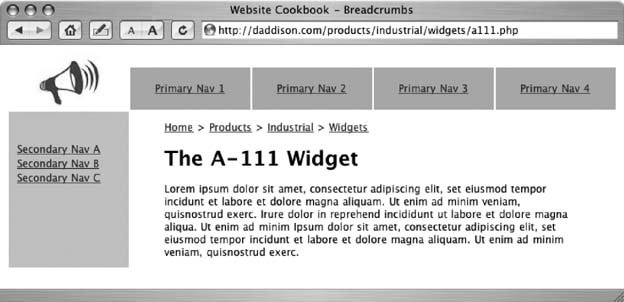Recipe 3.7. Creating Breadcrumb Links
ProblemYou need to help users navigate your site by putting a chain of links, or breadcrumb, that matches your site structure. SolutionUse a PHP script to generate the links on-the-fly from the directory names on your web site (see Figure 3-8). DiscussionBreadcrumb links make a nifty addition to your site's navigation. Although they shouldn't replace a site's primary or secondary navigation, they give visitors an additional tool to use when browsing a deep site. Figure 3-8. Breadcrumb navigation shows a trail of links that mirrors a site's structure Using the names of your web site directories, this PHP script creates links to the main pages in every directory above the current page. <? $full_path = substr(getenv("REQUEST_URI"),1); $full_path = trim($full_path,"\/"); $bc = split("\/", $full_path); First, the script defines the variable $full_path as the names of the directories and the file that are part of the current page's URL (leaving out the http:// and the domain name) and trims the leading and trailing slashes from the string. Using the split() function, the script turns the string value of $full_path (products/industrial/widgets/a111.php) into a four-value arraythree directory names and a filename. Next, the script will take a closer look at the filename (or lack thereof) of the URL that has been requested. if (strstr(end($bc), "index")) { $j=2; } else { $j=1; } The if condition tests the last value of the directories and filename array, end($bc). If it contains the text index, then the script assigns the value 2 to the temporary variable $j, which will play a role in the for loop that builds the links. for ($i=0;$i<(sizeof($bc)-$j);$i++) { The loop starts at the first element in the array, but the number of array elements it turns into links depends on the value of $j. We never want the script to create a link to the last value of the array. That value is either the current filename (a111.php) or a directory name, meaning the visitor has requested the main page in a directory with a URL that ends with a trailing slash and no filename. When the visitor does request index.php, then a $j value of 2 stops the loop two values short of the end of the array $bc, because we don't want self-referencing links to index.php or the directory that contains it in the bread-crumb. Now that we know how many of the elements in the path array we need to deal with, the script can begin to construct the links, which will be compiled in the variable $bc_path. $bc_start = strpos($full_path,$bc[$i]); $bc_length = $bc_start+strlen($bc[$i]); $bc_link = substr($full_path,0,$bc_length); $bc_text = ucfirst($bc[$i]); $bc_path .= " > <a href=".$bc_link."/>".$bc_text."</a>"; } For each element in the array$bc[$i]the script calculates its starting ($bc_start) and ending ($bc_length) character positions in $full_path. For widgets, this would be 21 and 27. Then the substr( ) function extracts the link$bc_linkfrom the start of $full_path to the end of the current value of $bc[$i]. The ucfirst() function gives the link text $bc_text first-letter capitalization, and then its value is concatenated with the link code in $bc_path and printed on the web page. echo "<p><a href=\"/\">Home</a> ".$bc_path."</p>"; ?> See AlsoRecipe 2.3 |
EAN: 2147483647
Pages: 144